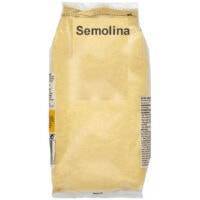Semolina
Semolina is a high gluten flour from hard durum wheat. It has a rather coarse texture, yellow colour, and is high in gluten protein.
The high gluten content means the flour is especially well suited for making pasta.
However, this flour is also a common ingredient in bread and baked goods as well as couscous. Semolina is available throughout the world but is most popular in Italy.
Varieties of Semolina
Semolina flour is either in coarse, medium, and fine textures. The most common is medium grind,. The fine grind is similar in texture to all-purpose flour.
One of the most common uses for this flour is making pasta from scratch. I
t is an ideal flour because of the gluten content, which creates a less sticky dough and is much more elastic than other flours.
This helps the pasta hold its shape when cooking, whether that shape is a long spaghetti noodle or an elbow.
It is also used to make couscous, which is simply moistened semolina that is mixed until little balls form.
In addition, this flour is good for making bread, cakes, and pizza, as well as porridge and pudding.
In Morocco, This flour (called smida) is the key ingredient in khobz, an oven-baked round flatbread
And it finds its way into cakes in countries like Greece and Turkey. In India, where it is referred to as rawa or sooji, it is cooked into a porridge.
It is used for sweet puddings in Europe and is a staple ingredient in Nigeria, where it’s boiled with water and eaten with stews and soups.
It1 is also commonly sprinkled onto pizza pans.
Semolina Recipes
Any type of fresh pasta is preferably made with IT flour, and there are many African, Mediterranean, and Middle Eastern dessert and bread recipes that call for semolina





